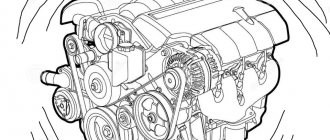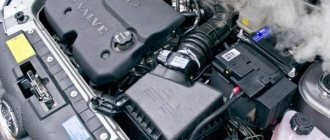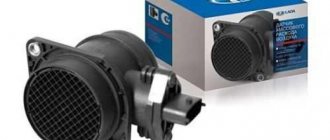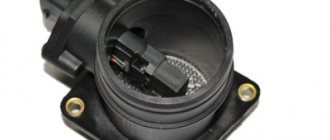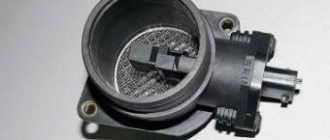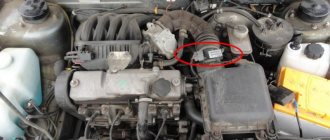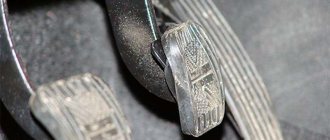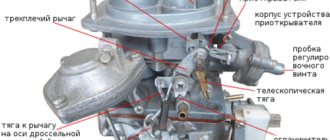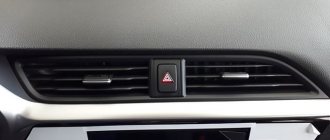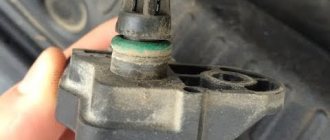Reliable operation of a car engine is achieved through the correct operation of all internal combustion engine components. The VAZ 2114 is equipped with an injection engine, which is demanding on the frequency of the system and its tightness. The slightest deviations from the permissible values lead the engine to emergency operation. In order for the engine to operate correctly, it is necessary to carefully monitor the tightness of the intake system.
All air entering the engine must be taken into account by the air flow sensor, but it happens that unwanted air leaks appear in the car, which lead to unstable operation of the engine in all its operating modes.
This article talks about how air leaks affect the operation of the VAZ 2114 engine, as well as ways to find and eliminate it. It is quite difficult to find the air leak on your own, but after studying our article, you can easily find the unfortunate place where the system is depressurized.
How does air leakage affect the operation of the internal combustion engine?
For reliable operation of the internal combustion engine, a sealed air intake system is needed. This is necessary for accurate preparation of the fuel mixture. The engine control unit prepares the air-fuel mixture based on the readings of the mass air flow sensor (MAF). The air passing through the mass air flow sensor is counted and transmitted to the control unit, which sends a signal to the injectors and opens them and keeps them open until the required amount of fuel is supplied to create the correct mixture. This operation of the internal combustion engine is correct, but when unwanted air leaks appear in the engine after the mass air flow sensor, its volume increases.
It turns out that the air flow sensor transmitted readings to the ECU about the same amount of air passing through it, but in fact, due to suction, the air volume is much larger than it should be, but the ECU does not know about it. Because of this, the fuel mixture is formed incorrectly.
How can “extra” air enter the cylinders?
Excess air can enter the fuel mixture not only directly through a violation of the intake manifold gasket, but also through the parts associated with it. Let's take a closer look at possible places where the integrity of the intake tract is damaged for carburetor and injection engines separately.
Carburetor engine
Possible places for air leaks at the inlet
Possible “weak points”:
A common cause of air leaks is deformation of the carburetor “sole” when the carburetor is tightened on a hot engine.
- carburetor gasket;
- carburetor diaphragm. These are mainly the diaphragms of the trigger device and the damper drive of the second chamber - not all models have the latter;
- vacuum hoses for controlling the advance angle (goes to the distributor), for all kinds of pneumatic valves; also sometimes the carburetor fittings themselves are not tightly inserted into the body at the factory;
- deformation of the “sole” of the carburetor; A very common cause of choke is caused by the carburetor being tightened on a hot engine.
Injection engine
Suction is possible through:
Generalization
In addition, for both types of engines, suction is possible through a damaged brake booster vacuum hose, as well as through the seal of its valve (fitting) inserted into the booster housing. Moreover, many car enthusiasts ignore the fact that if the free play of the brake light switch (“frog”) is incorrectly set, the correct operation of the amplifier itself can be disrupted, as a result of which air intake from it will be “incorrect”, which will cause excessive air intake into the intake collector. The correct setting of the “vacuum valve” is also influenced by the amount of protrusion of its rod from the body. The most unpleasant thing in this situation is that air leakage “through” the vacuum booster cannot be detected from the outside during inspection.
Signs of air leaks
Incorrect formation of the fuel mixture leads to unstable operation of the internal combustion engine and with this problem the following symptoms are observed:
- Difficulty starting the engine when cold after a long period of inactivity;
- Unstable idling, speed jumps from 500 to 2000 rpm are observed;
- Increased engine vibration at idle;
- Loss of power and former dynamics of the car; to accelerate the car you need to press harder on the gas pedal;
- Fuel consumption increases;
These signs indicate a problem with the vehicle and require a quick solution to the problem. It should be noted that these symptoms can arise for other reasons, but checking the engine for air leaks is one of the number one points in solving problems in the operation of the internal combustion engine.
Places where there may be suction
Air leakage can be anywhere where it passes to the combustion chamber, be it the intake corrugation or the receiver. There are several places where system depressurization occurs quite often.
Places of possible suction:
- Joints of the corrugation with the sensor and throttle assembly;
- Idle air control;
- Small breather;
- Vacuum brake booster;
- Absorber tubes;
- Injector rings;
- Intake receiver gaskets;
All of the above places are prone to air leaks in the VAZ 2114 system and if leaks are suspected, it is necessary to inspect these particular suspicious places.
Briefly about each place
Corrugated joints
The corrugation is connected to the throttle assembly and the mass air flow sensor through a clamp; sometimes this clamp may not provide reliable tightening, which leads to suction.
RXX
The idle air control is installed in the remote control through an o-ring, which ensures the tightness of the system. Often this ring loses its properties and begins to let air through.
It should be noted that the IAC is installed only on cars with a mechanical throttle.
Breather
The small breather communicates with the intake corrugation through a clamp; relaxation of this clamp leads to possible air leakage in front of the throttle assembly.
VUT
The vacuum brake booster is connected to the intake receiver through a special hose, which can become damaged and begin to let in unwanted air; also in the VUT, the membrane and intake fitting are often damaged, which leads to air leaks through the brake booster.
Injector rings
To seal the junction of the injectors with the cylinder head, special rubber rings are used, which ensure reliable tightness of the system and prevent its depressurization. Due to high temperatures, rubber rings tend to lose their elasticity and become rigid, which leads to air leakage through them.
Receiver seals
The plastic receiver is connected to the cylinder head through rubber sealing rings that adhere to the surface of the head. Due to high temperatures, they lose their properties and begin to let in excess air.
conclusions
The optimal methods for diagnosing air leaks in the intake manifold on your own remain the use of smoke and spraying the manifold, corrugations, and throttle bodies with a thin stream of flammable liquid. Good luck with your diagnostics and smooth roads!
For normal operation of the internal combustion engine, a certain composition of the air-fuel mixture is required, in a ratio of 1:14, 1:16. That is, for complete combustion of one liter of gasoline, 14-16 kg of air is needed. If this proportion is observed, the engine operates stably, in economical mode and with full power output. If the composition of the mixture is violated, problems begin with the operation of the power plant. One of the reasons for changes in the composition of the fuel mixture is additional air in the connections. In this case, the mixture becomes leaner due to additional air, which immediately affects the operation of the engine.
Symptoms of malfunction:
• Dips or the engine may stall when gas is supplied suddenly;
• Problems with starting (the proportion of fuel becomes smaller, the mixture becomes leaner, and for a cold start it needs to be enriched);
• Reduced power and increased fuel consumption;
• Self-diagnosis shows errors regarding engine operation: lean mixture, misfires, faulty oxygen sensors.
How to find the location of the leak?
In most cases, excess air appears at the junction of joints of various parts or due to the formation of cracks in the parts themselves.
Most often, suction is observed in the following places:
• Throttle valve assembly;
• Hose with vacuum booster;
• Intake manifold seals;
• In the corrugation from the air filter to the throttle (the pipe itself or the connection points);
• Gaskets under the carburetor or through its elements (quality screw, starting diaphragm, damper axes and their ovality, economizer membranes);
• Fuel injector rings;
• When the adsorber valve is jammed.
Air leaks in diesel engines
Most often, a malfunction appears in the connections between the fuel tank and the pipe connections, as well as between the filter and the injection pump. On modern diesel engines, the suction is caused by a change in the design of the connections.
So in old motors the connections were made of brass and were essentially “eternal”, but in motors of the new type, brass was replaced with plastic, the service life of which is an order of magnitude lower. Plus, in winter, cracks may appear on the plastic, especially in cars with a mileage of about 150-200 thousand km.
Checking the internal combustion engine for air leaks
To make sure there is an air leak in the engine, there is no need to go to a service station and pay a tidy sum. You can check the presence of air leaks yourself.
- To do this, unscrew the mass air flow sensor from the air filter box and remove it.
- Next, start the car and close the inlet with your hand or some other object.
- With a sealed system, the engine should stall and the intake corrugation should compress and remain in a compressed position for several seconds.
If the car does not stall or stalls, but the corrugation does not compress, then most likely there is an air leak in the car and you need to start looking for it.
Engine Inspection
To identify air leaks, you must first understand how the engine intake system works.
Air enters through the air filter. The throttle valve controls it by creating a vacuum. Know that a car is leaking air when it makes a hissing sound after starting.
Vacuum hoses wear out during operation and become brittle. This leads to their damage. Carefully inspect the hoses on the engine and replace them if necessary. The engines are different from each other. Refer to the repair manual for hose identification.
How to find the leak location
Air leaks can be found in several ways. The most popular method is a smoke generator, but if this is not available, then you can use a regular soap solution.
Using a smoke generator
A smoke generator is a device that produces a large amount of smoke. It is connected to the intake system, smoke spreads throughout the system and begins to seep out in places where there is no tightness.
Video
With pump and soap
Finding the place where air leaks occur without a smoke generator can be done using a soap solution.
To do this, prepare soapy water.
- Next, we close the mass air flow sensor with a plastic bag, namely, we put the bag on the sensor, then we put a clamp with corrugation on top.
- We connect a compressor or pump through the absorber fitting and pump pressure into the system.
- Then we water all suspicious areas with soapy water.
- In those places where there is air leakage, soap bubbles will begin to inflate.
Where exactly can air be sucked from?
There are quite a lot of places for the passage of unaccounted air. You need to understand that the culprit may be either a leaky rubber band or a crack in the intake manifold.
Most often, air is sucked from:
If you suspect that there is unaccounted air in the intake manifold, you should immediately check all of the above areas. As a rule, the suction is quite easy to find. If difficulties arise, it is recommended to seek help from a service station or acquire a special device for searching for intake leaks.
